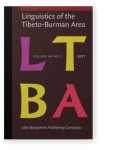Vol. 40:2 (2017) ► pp.243–284
The (pro)nominalizer -la(ŋ) in Tamangic
Its link to genetives, complementizers, and finite verb suffixes
As is well known, it is not uncommon in TB that nominalized clauses are used in various types of constructions, such as relative clauses, purpose clauses, verb complements, and free-standing independent clauses. Noonan (1997), for instance, shows the multi-functionality of the nominalized clause with a nominalizer -wa in Chantyal (Tamangic). The current article discusses another nominalizer -la(ŋ) in Tamangic. In many Tamangic languages/dialects the suffix la(ŋ) may be used to form possessive pronominal expressions (e.g. ‘someone’s/something’s one’). It can thus be more specifically described as a pronominalizer. There is evidence that in many Tamangic dialects the suffix has developed into a genitive marker. This paper further suggests a possibility that la(ŋ) is historically related to a number of verb suffixes, such as complementizers and finite verb suffixes used in free-standing independent clauses.
Article outline
- 1.Introduction
- 2.The (pro)nominalizer -la(ŋ) in Tamangic
- 3.The development of a new genitive
- 4.Other usages of the modern reflexes of *-la
- 5.Verb suffixes
- 5.1Complementizers or infinitive suffixes
- 5.2Finite morphology
- 5.2.1 -pala
- 5.2.2 -la and -la(ŋ)
- 6.Beyond Tamangic
- 7.Conclusions
- Acknowledgements
- Notes
- Abbreviations
-
References
